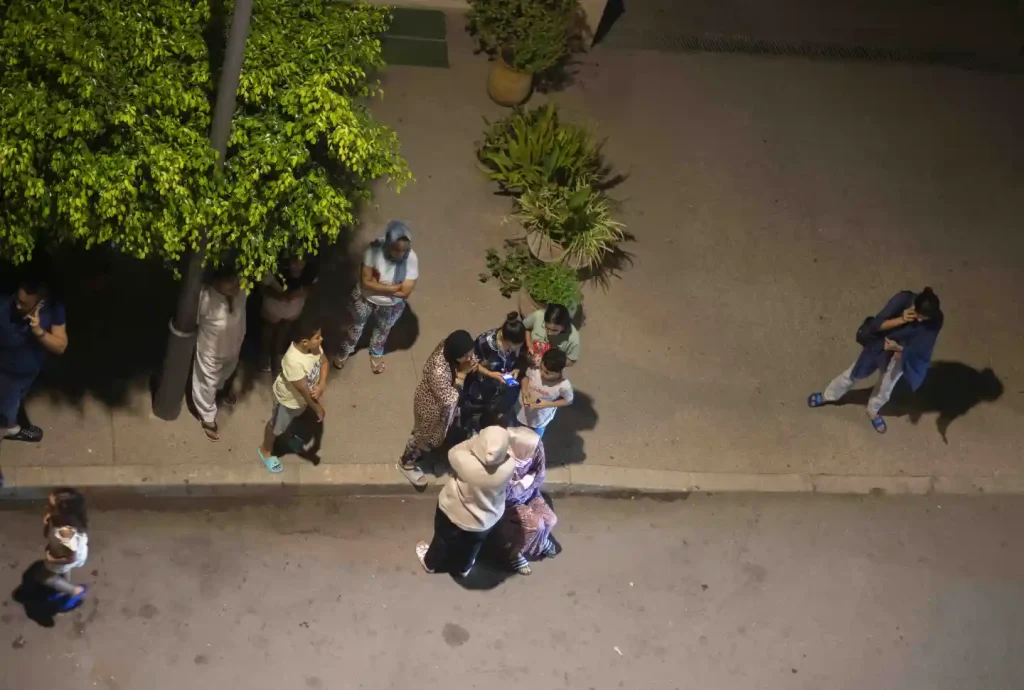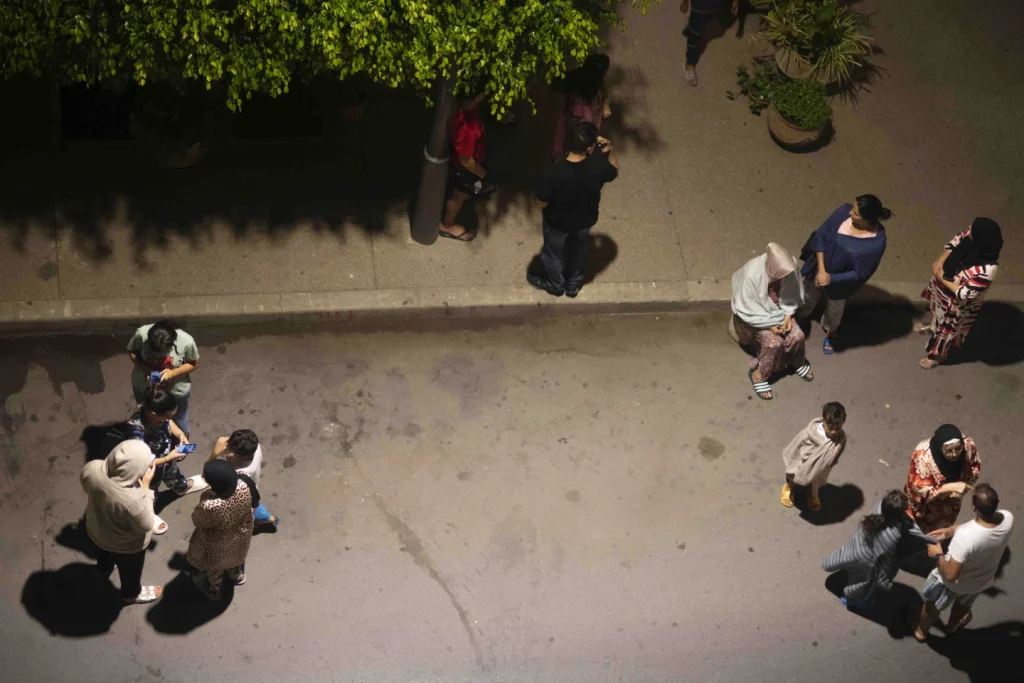In the wake of a rare and devastating earthquake that rattled the picturesque landscapes of Morocco, the nation finds itself reeling from the tragic loss of life and extensive damage to its infrastructure.
Late Friday night, a seismic event of considerable magnitude struck the region, leaving in its wake a trail of destruction that stretched from the tranquil villages nestled within the Atlas Mountains to the vibrant and historically significant city of Marrakech.
The gravity of the situation was underscored by the Moroccan Interior Ministry, which confirmed in the early hours of Saturday morning that a staggering death toll of at least 296 individuals had been recorded in the provinces most affected by the quake.
Moreover, an additional 153 individuals were reported to have sustained injuries requiring immediate medical attention, prompting their transportation to nearby hospitals.
The ministry further elaborated that the majority of the damage incurred was concentrated in rural areas, sparing the urban centers to a certain extent.
In the aftermath of this calamitous event, Moroccan television broadcasts have captured the harrowing scenes of survivors seeking solace in the open air, gripped by the fear of potential aftershocks that could further exacerbate the already dire situation.
In the face of a devastating catastrophe, anxious families found themselves standing in the streets or huddled together on the cold pavement, their expressions etched with worry and fear.
Some clutched their children tightly, seeking solace and reassurance in their presence, while others held onto blankets or other cherished belongings, perhaps offering a sense of familiarity and comfort amidst the chaos.
As emergency workers tirelessly maneuvered through the debris, their determined efforts were evident as they climbed over heaps of stones, remnants of once sturdy walls that now lay in ruins.
The scene was punctuated by a haunting sight – a car, almost entirely concealed by the weight of massive chunks of a collapsed building, a stark symbol of the immense destruction that had unfolded.
In the aftermath of the devastating earthquake, the landscape was strewn with a chaotic jumble of scattered stones, interspersed with the remnants of buildings, including baskets, buckets, and fragments of clothing.
The immediate aftermath of the quake was captured through powerful images shared online, depicting scenes of panic and terror as people ran and screamed near the magnificent 12th century Koutoubia Mosque in Marrakech, an iconic and revered landmark of the city.
Reports from Moroccan media indicated that the mosque had indeed suffered damage, although the full extent of the destruction remained uncertain at that time.
Notably, the mosque’s towering minaret, reaching a height of 69 meters (226 feet), is famously known as the “roof of Marrakech,” further emphasizing its significance and the potential gravity of the damage inflicted upon it.
Additionally, videos shared by Moroccans showcased the partial destruction of sections of the renowned red walls that enclose the old city of Marrakech, a site of immense cultural and historical value, recognized as a UNESCO World Heritage site.
The gravity of the situation was further highlighted by the accounts of the head of a town located near the epicenter of the earthquake, who revealed that several homes in nearby towns had either partially or completely collapsed.
Moreover, the disruption caused by the earthquake had severed access to electricity and rendered roads impassable in certain areas, exacerbating the challenges faced by affected communities.
Abderrahim Ait Daoud, the esteemed head of the town of Talat N’Yaaqoub, has conveyed that the authorities are diligently engaged in their efforts to clear the roads in Al Haouz Province.
This crucial task is aimed at facilitating the passage of ambulances and aid to the populations that have been grievously affected by the recent calamity.
However, it is important to note that the vast expanse of the mountainous terrain has created significant challenges, thereby necessitating a considerable amount of time to accurately ascertain the full extent of the damage.
This intricate process is further compounded by the substantial distances that separate the various villages nestled within these majestic mountains.
It is through the collective determination and resilience of the authorities, as well as the unwavering support of the community, that hope is kindled amidst this arduous journey towards recovery and healing.

According to local media reports, the roads leading to the mountain region surrounding the epicenter of the earthquake were heavily congested with vehicles and obstructed by collapsed rocks, which significantly impeded the progress of rescue operations.
The U.S. Geological Survey (USGS) indicated that the initial magnitude of the quake was recorded at 6.8 when it struck at precisely 11:11 p.m. (2211 GMT), with the tremors lasting for several seconds.
The USGS further reported that a magnitude-4.9 aftershock occurred 19 minutes later. The epicenter of the tremor that occurred on Friday was situated near the town of Ighil in Al Haouz Province, approximately 70 kilometers (43.5 miles) to the south of Marrakech.
While the USGS stated that the epicenter was located 18 kilometers (11 miles) beneath the Earth’s surface, Morocco’s seismic agency estimated it to be at a depth of 8 kilometers (5 miles).
Irrespective of the specific depth, shallow earthquakes such as this one pose a greater risk and are more hazardous.
Earthquakes are a relatively rare occurrence in North Africa, making them an unusual and noteworthy event when they do occur.
Lahcen Mhanni, the esteemed Head of the Seismic Monitoring and Warning Department at the esteemed National Institute of Geophysics, recently made a statement on 2M TV regarding a particularly powerful earthquake that struck the mountain region.
According to Mhanni, this earthquake stands as the strongest ever recorded in the area, further emphasizing its significance.
With his extensive expertise and knowledge in the field, Mhanni’s statement carries weight and adds an extra layer of importance to this seismic event.
This occurrence serves as a reminder of the unpredictable nature of our planet and the need for continuous monitoring and research in the field of seismology.
The devastating earthquake that occurred in 1960 near the Moroccan city of Agadir remains etched in history as one of the deadliest natural disasters to have struck the region.
With a magnitude of 5.8 on the Richter scale, this tremor unleashed widespread destruction, claiming the lives of thousands of individuals and leaving a lasting impact on the affected communities.
The repercussions of this catastrophic event were felt not only in terms of the immediate loss of human life but also in the long-term consequences it had on the city’s infrastructure, economy, and the collective psyche of its inhabitants.
The Agadir earthquake serves as a somber reminder of the unpredictable forces of nature and the importance of preparedness and resilience in the face of such calamities.
The devastating Agadir earthquake of 1960, with a magnitude of 5.7, shook the very foundation of Morocco, both literally and metaphorically.
This seismic event, which claimed the lives of thousands and caused widespread destruction, served as a wake-up call for the nation’s construction industry.
In the aftermath of this catastrophic event, the Moroccan government recognized the urgent need for stricter regulations and guidelines to ensure the safety and stability of buildings in earthquake-prone areas.
Consequently, significant changes were made to the construction rules and regulations, particularly in urban areas, to mitigate the risks associated with future seismic activities.
However, despite these commendable efforts, it remains a disheartening reality that many buildings, especially those in rural areas, have not been constructed to withstand such tremors.
This discrepancy can be attributed to various factors, including limited resources, lack of awareness, and the challenges faced by marginalized communities.
Consequently, these vulnerable structures are at a higher risk of collapse during earthquakes, posing a grave threat to the lives and well-being of the inhabitants.
It is crucial for the government and relevant stakeholders to address this issue urgently, by implementing comprehensive strategies to retrofit and reinforce existing structures, as well as by ensuring that new constructions adhere to the latest seismic building codes.
By doing so, the nation can take significant strides towards minimizing the potential devastation caused by earthquakes and safeguarding the lives of its citizens.
The seismic impact of earthquakes knows no boundaries, as evidenced by the fact that the tremors from the Agadir quake were felt as far away as Portugal and Algeria.
This assertion is supported by the Portuguese Institute for Sea and Atmosphere and Algeria’s Civil Defense agency, which oversee emergency response in their respective countries.
The sheer magnitude of this seismic event reverberated across borders, serving as a stark reminder of the interconnectedness of our world and the need for international collaboration in disaster management.
As such, it is imperative for neighboring countries to learn from Morocco’s experience and take proactive measures to enhance their own preparedness and response capabilities.
By sharing knowledge, resources, and best practices, nations can build resilience and effectively mitigate the devastating impacts of earthquakes.

In conclusion, the Agadir quake of 1960 remains etched in the collective memory of Morocco, serving as a poignant reminder of the destructive power of earthquakes.
While commendable steps have been taken to improve construction regulations, there is still much work to be done, particularly in rural areas where vulnerable structures persist.
The international community must also recognize the transboundary nature of seismic events and collaborate to enhance preparedness and response efforts.
Only through concerted action can we hope to minimize the loss of life and property caused by earthquakes and build a safer, more resilient future for all.
